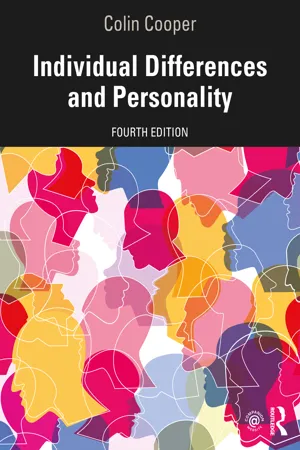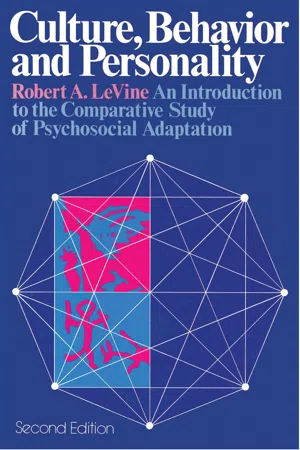Psychology
Measuring Individual Differences
Measuring individual differences involves assessing and quantifying the variations in psychological characteristics among people. This can include traits such as intelligence, personality, and abilities. Psychologists use various methods, such as tests and questionnaires, to measure these differences, which can provide valuable insights into understanding human behavior and predicting outcomes in different contexts.
Written by Perlego with AI-assistance
Related key terms
8 Key excerpts on "Measuring Individual Differences"
- eBook - ePub
- Bere Mahoney(Author)
- 2011(Publication Date)
- Learning Matters(Publisher)
Cervone, 2005 ). This relatively narrow focus has, to some extent, been aggravated by the effects of specialisation – or separatism – in the field, a trend that some regard as problematic because:a much richer picture of humanity and psychological diversity is brought into focus when constellations of individual-differences variables are assembled for research and practice.(Lubinski, 2000 , p407)In Chapter 2 you will therefore consider how the relationship between individual differences psychology and other fields in psychology is increasingly being questioned (Sternberg et al., 2001 ). Nevertheless, the psychometric approach remains dominant in the field, meaning that the integrity of individual differences psychology continues to depend on the soundness of this approach.The term psychometrics literally means the measurement of psychological phenomena or mental processes (Bartram and Lindley, 2005 ), and in individual differences psychology this means the measurement of psychological phenomena we refer to as individual differences. Measurements or measures of individual differences we collect in the field are therefore central to the psychometric approach. Measures of individual differences, or individual differences data, are used in real contexts to make important decisions about individuals or groups of individuals (Lubinski, 2000 ; Revelle et al., 2010 ). Consequently, the measurements we use in individual differences psychology, along with the methods we use to collect the data that form these measures, have social significance. This is because they are used in real contexts to make important decisions about individuals or social groups (Lubinski, 2000 ; Revelle et al., 2010 ). The field’s contribution to such high-stakes decision making about individuals and groups in the domains of education, work, mental health and the criminal justice system remains unabated and substantial (Revelle et al., 2010 ). Thus the theoretical and empirical findings of the field have both academic and real world significance. The reality is that the access of individuals and social groups to certain resources and opportunities in the domains of education, training, work and within the criminal justice system involve the collection and interpretation of individual differences measures and data. This means that when working in the field – whether as academics, practitioners or students – our conduct is of ethical and professional importance. In this chapter we will therefore also consider some of the ethical and professional responsibilities we have in the field. Our overarching responsibility is to ensure that we competently and respectfully uphold the highest possible standards of quality in the methods of data collection we use, the data we collect and our interpretation of such data, or its analysis and evaluation. The importance of these issues means we will return repeatedly to these issues throughout this book. Ethics and professional conduct are also issues that are an important part of your reflective critical thinking - eBook - ePub
- Colin Cooper(Author)
- 2020(Publication Date)
- Routledge(Publisher)
Chapter 3Measuring Individual Differences
Introduction
The previous chapter mentioned the use of a questionnaire to measure self-esteem, but it did not go into any detail about how questionnaires and tests are constructed, used and evaluated. If we are unable to actually measure people’s levels of self-esteem, anxiety, intelligence or other characteristics accurately, then the study of individual differences can never be scientific or quantitative; it will be difficult to test theories, or to assess these characteristics for the purpose of diagnosis, individual guidance or personnel selection. So before studying other theories it seems sensible to pause and to discuss how we can go about Measuring Individual Differences; more detail about designing and using tests and questionnaires is given in Chapters 20 and 21 .This chapter thus provides an introduction to psychometrics, the branch of psychology that deals with the measurement of individual differences. It introduces the concepts of trait and state. Various types of psychological test are outlined and the interpretation of individual scores through the use of norms is discussed. Finally, some guidance is given as to how to select a test and use it ethically. - eBook - ePub
Perspectives on School Learning
Selected Writings of John B. Carroll
- L. W. Anderson(Author)
- 2014(Publication Date)
- Routledge(Publisher)
In recent years, psychologists of many stripes and colors have again turned their attention to the study of the mind. We now have a thriving branch of psychology that may be called experimental cognitive psychology, with subspecialties concerned with the study of memory, language, perception, and other traditional psychological functions. One outcome of this development has been a focus on the role of individual differences in learning and performance. Experimental psychologists no longer regularly sweep individual variation under the rug of an error term that is used only for testing effects of experimental treatments. Experimental designs increasingly allow for the study of interactions of treatments with individual or group differences. Some cognitive psychologists have posed the interesting question of whether individual differences observed in experimental settings have relevance for understanding the nature of intelligence and mental abilities. In some quarters — though it is hard to say exactly where this idea started — it has been proposed that measurements of individual differences taken in certain kinds of experimental laboratory settings, perhaps at computer terminals, might replace or at least supplement the kinds of measures that have traditionally been used to assess intelligence or mental abilities.For the past year, I have spent a good part of my time examining these developments, trying to decide what prospects there are for using them to understand mental ability, or to provide valid and reliable measurements of ability. I have no new data or findings to report, except in the form of a metaanalysis, if you will, of other people’s findings. Even after an intensive survey of relevant literature, in which, among other things, I have done something like 25 factor analyses of other people’s data sets, I find it difficult to formulate overall conclusions, except in terms of the problems I have encountered and the large gaps in our knowledge I have discovered. It would be easy for me to summarize my impressions by saying that the field is “in a mess,” but such a statement would be too strong and not very constructive or hopeful. What I shall try to do is to render my judgment of the “state of the art” and state where I think the field is “at.” I will discuss how notions of ability and task difficulty are treated in cognitive psychology, and present a few of the major findings in this field. - John M. Spores(Author)
- 2023(Publication Date)
- Routledge(Publisher)
Chapter 6 Psychological Measurement Enhancing Diagnostic Precision and Accuracy Using Standardized TestingDOI: 10.4324/9781003308164-6Overview
Psychological measurement (or psychometrics) is the science of measuring the variability among people on vital characteristics, traits, or constructs. This includes assessing the quality of psychological tests, which purport to measure such individual differences (Furr, 2018 ; Furr & Bacharach, 2014 ; Price, 2017 ). The dual objective of this final chapter is as follows: (a) to acquaint the reader about how psychological testing basically works; and (b) when it should be requested in mental health practice to facilitate diagnosis, case conceptualization, and treatment planning. To accomplish this objective, fundamental concepts and principles of psychological measurement are subsequently defined and elaborated upon as deemed necessary to promote comprehension. To further enhance both understanding and interest, each concept and principle is demonstrated by means of an example. This is accomplished by showing how a hypothetical psychological test is developed and standardized. From this presentation, it is hoped that the reader will gain greater insight as to how and why psychological testing can add both efficiency and precision to psychodiagnosis, case formulation, and treatment planning.The Measurement of Psychological Constructs
Concepts are symbols or ideas that represent things, events, relationships among events, and characteristics, all of which we use in general language in order to communicate with others (Marx, 1963 ). More precisely defined concepts lead to clearer communication. In mental health practice, we frequently assess key characteristics of people that are only indirectly observable. Such characteristics have been alternately termed constructs, latent variables, and underlying factors.1- eBook - ePub
Human Performance
Cognition, Stress and Individual Differences
- D. Roy Davies, Gerald Matthews, Rob B. Stammers, Steve J. Westerman(Authors)
- 2013(Publication Date)
- Psychology Press(Publisher)
Individual differences in ability and performance14.1 Investigating Individual DifferencesOn any task, some people perform better than others, even when the amount of practice is controlled. Individuals differ in their ability or basic aptitude for performing the task concerned. This chapter addresses the nature and practical significance of individual differences in ability. Research on ability and performance brings together several rather different research traditions. These include psychometric research focused on detailed statistical modelling of ability, applied research geared to predicting real-world performance, and cognitive psychological research concerned with individual differences in information processing. Hence, the chapter focuses on the interrelation of three types of construct:- Psychometric ability factors such as general intelligence or g , such as those measured by conventional IQ tests. Ability tests aim to abstract some general quality which may relate to individual differences in performance on a variety of tasks.
- Measures of laboratory and real-world task performance (molar measures). Ability research is concerned with the prediction and understanding of individual differences in performance.
- Elementary information-processing constructs, with a basis in theory (molecular measures). Researchers often wish to explain individual differences in performance on more complex tasks in terms of specific processes.
14.1.1 Theory and practice in ability research
The first step in ability research is to describe and characterise the major dimensions of ability. In the intelligence field, for example, there has been much debate between researchers who favour a single overarching ability (g - Steven G. Rogelberg(Author)
- 2016(Publication Date)
- SAGE Publications, Inc(Publisher)
Individual Differences Individual DifferencesRose Mary Webb Rose Mary Webb Webb, Rose Mary701 706Individual Differences
Rose Mary WebbIndividuals differ from one another behaviorally in many ways. Differential psychology, the scientific study of these individual differences, provides an organizational structure for this vast array of psychological attributes. By examining broad behavioral patterns and using systematic assessments of relatively stable personal attributes, differential psychology allows longitudinal forecasting of a variety of important life outcomes. Because much of the research in this area focuses particular attention on predicting long-term life outcomes, and because work is such a large and important feature of adult life, the relationships between many commonly investigated individual difference constructs and various aspects of work behavior (e.g., educational-vocational choice, acquisition of job-related knowledge, job performance, job satisfaction, citizenship, tenure) are well understood.Methodological Considerations
Traditionally, the measurement of individual differences has relied on psychometric scales based on the aggregation of many items. Because any single item on a scale represents only a sliver of information about a personal attribute, aggregation is used to create a composite of several lightly correlated items. This approach distills the communality running through the items and constitutes highly reliable and useful information about the human characteristic under analysis.- eBook - ePub
- Wayne F. Cascio, Herman Aguinis(Authors)
- 2018(Publication Date)
- SAGE Publications, Inc(Publisher)
6 Measuring and Interpreting Individual Differences Wayne F. Cascio, Herman AguinisLearning Goals
By the end of this chapter, you will be able to do the following:- 6.1 Distinguish among nominal, ordinal, interval, and ratio scales of measurement and learn which types of data analysis can be conducted with each
- 6.2 Implement procedures and criteria for choosing to use an existing test or develop a new one
- 6.3 Understand the use of item response theory to conduct comprehensive item analyses
- 6.4 Estimate reliability using procedures such as test–retest, parallel forms, internal consistency, and interrater reliability to assess different sources of error (e.g., time, items, raters)
- 6.5 Interpret and use reliability information
- 6.6 Understand the use of generalizability theory to learn about the relative contribution of different sources of error
- 6.7 Create measures that minimize the detrimental effects of scale coarseness and interpret results of measurement procedures, taking into account norms and other contextual issues
- 6.8 Anticipate future trends in applied psychological measurement given technological and other contextual changes
Have you ever visited a clothing factory? One of the most striking features is the vast array of clothing racks, each containing garments of different sizes. Did you ever stop to think of the physical differences among wearers of this clothing? We can visualize some of the obvious ways in which the people who will ultimately wear the clothing differ. We can see large people, skinny people, tall people, short people, old people, young people, and people with long hair, short hair, and every imaginable variant in between.Applied psychology’s first law is glaringly obvious: People are different. They differ not only in physical respects but also in a host of other ways (Sackett, Lievens, Van Iddekinge, & Kuncel, 2017). Consider wearers of size 42 men’s sport coats, for example. Some will be outgoing and gregarious, and others will be shy and retiring; some will be creative, and others will be unimaginative; some will be well adjusted, and some will be maladjusted; some will be honest, and some will be crooks. Physical and psychological variability is all around us. As scientists and practitioners, our goal is to describe this variability and, through laws and theories, to understand it, to explain it, and to predict it. Measurement is one of the tools that enables us to come a little bit closer to these objectives. Once we understand the why of measurement, the how - eBook - ePub
Culture, Behavior, and Personality
An Introduction to the Comparative Study of Psychosocial Adaptation
- Robert A LeVine(Author)
- 2018(Publication Date)
- Routledge(Publisher)
Part IV The Study of Individual Dispositions in Social SettingsPassage contains an image
12
Strategies in Personality StudyIn 1936 Ralph Linton, contemplating the problem of studying personality cross-culturally, complained, “It is unfortunate that we have no exact, objective techniques for identifying psychological types” (p. 484). Thirty-five years later, we have a multitude of personality tests for which exactness and objectivity are claimed, but the major obstacle to a comparative psychology of human populations remains the lack of dependable instruments for diagnosing the individual case. The contemporary anthropologist seeking a method of personality assessment for comparative study finds that: reputable personality psychologists do not agree on which method is best for measuring any particular disposition; different methods of measuring the “same” disposition correlate poorly or not at all, yielding differing distributions of results for the same group of individuals; and there is doubt and disagreement about the extent to which the methods tap enduring dispositions of the person or his reactions to the immediate conditions under which behavior is sampled. In fact, social and personality psychologists are currently engaged in intense and fundamental self-criticism regarding the validity of their methods (see Rosenthal, 1966; Berg, 1967; Mischel, 1968; Yarrow, Campbell and Burton, 1968; Rosenthal and Rosnow, 1969).The methodological plight of personality psychology is well portrayed in Personality Tests and Reviews (Buros, 1970), a massive compendium based on the Mental Measurements Yearbooks. Of the 513 personality tests developed over the past 40 years (96 projective and 417 non-projective tests), more than three-quarters are still in print and “are still being sold.” This durability might lead one to believe that they have proven their worth. But the compiler tells us:The size of the monograph [Personality Tests and Reviews]
Index pages curate the most relevant extracts from our library of academic textbooks. They’ve been created using an in-house natural language model (NLM), each adding context and meaning to key research topics.







